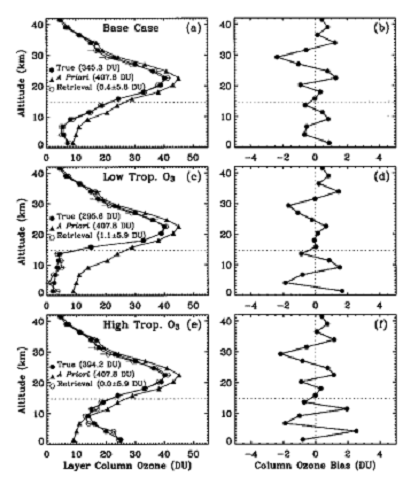A/C
Tropospheric Ozone Spectrometer
Liu, X., C.
E. Sioris, K. Chance, T. P. Kurosu, M. J. Newchurch,
R. V. Martin, P. I. Palmer (2005), Mapping tropospheric
ozone profiles from an airborne ultraviolet–visible
spectrometer, J. App. Opt., 44(16), June. Full
Text
Tropospheric ozone
retrieval using an airborne ultraviolet-visible spectrometer
is described and illustrated. This method is
described as a possible satellite validation technique
as well as its application for regional air-quality
studies. Regional measurements are important
because the temporal resolution of satellite-based
measurements (GOME) is insufficient compared to the
lifetime of ozone in the troposphere below 8 km.

Figure 4. (a) True, a priori,
and retrieved O3 profiles for the base case. (b)
Column O3 bias between retrieved and true profiles
in (a).(c)–(d), (e)–(f) Similar to (a)–(b)
but for two modified cases with low and high tropospheric
O3 conditions, respectively. The total O3 for the
true and a priori O3 profiles and the total
O3 bias in the retrieval are shown in parentheses.
The error bars on retrievals include both random-noise
errors and smoothing errors.
The above figure
illustrates the validity of the proposed tropospheric
ozone retrieval method. The retrieved profiles
agree well with the actual profiles in all cases
chosen.
|